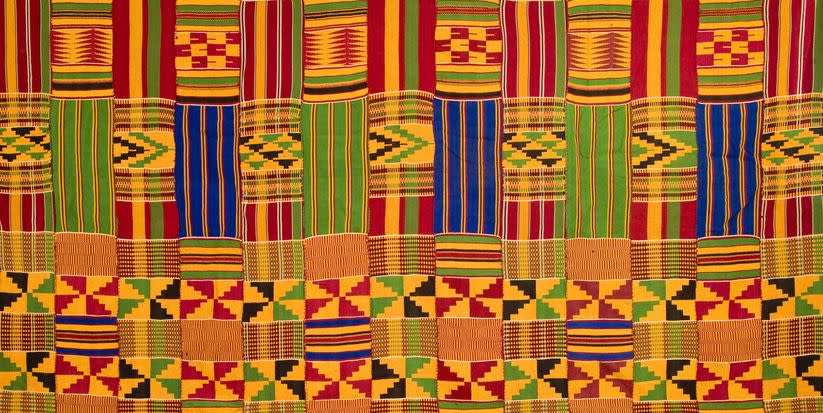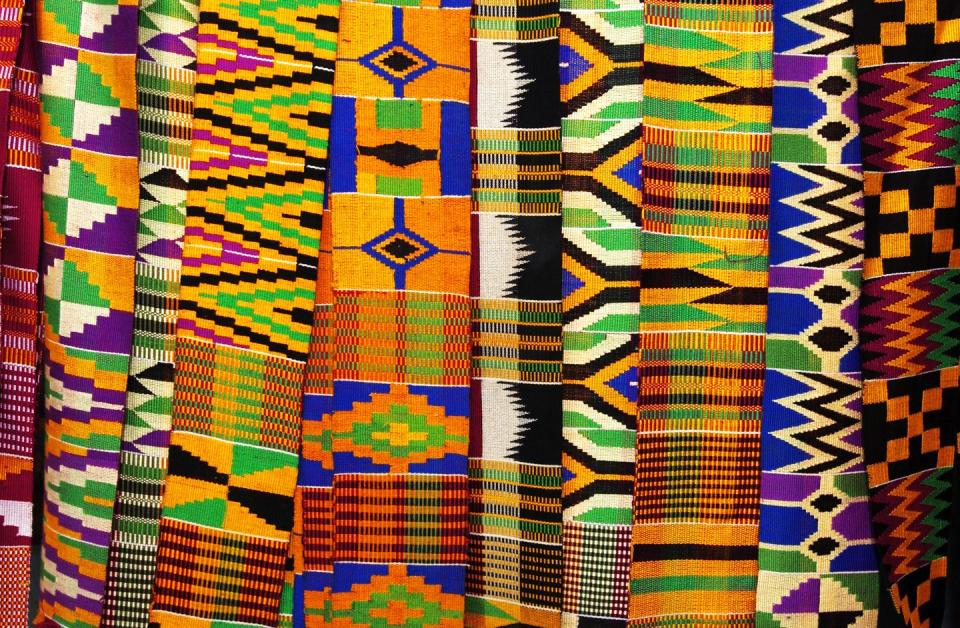What Is Kente Cloth?

Hold a piece of kente cloth between your fingers, and the first thing you notice is likely the bright, saturated shades of yellow, red, blue, and green. You might observe several rows of patterns, which are identical on the front and back of the cloth. That lets you know it was made by hand on a wooden loom. If you know what to look for, you may even be able to “read” it, gleaning a proverb or political statement from its threads.
Kente cloth comes from a textile practice that originated in Ghana centuries ago. The fabric has come to symbolize cultural affiliations from West Africa across the diaspora, but legend has it that a spider spinning a complex web inspired the earliest kente techniques and designs.
Weaving kente cloth is a cultural tradition of the Asante (also known as Ashanti) people, and these fabrics were originally used exclusively to dress kings and their courts. Each block, pattern, and color has a distinct name and meaning, and the cloth often includes adinkra symbols, which represent concepts or sayings. For example, an oft-used kente pattern is, in Twi, Woforo dua pa a na yepia wo. It means "when you climb a good tree you are given a push;" put another way, when one takes up a worthy cause, one will be supported by their community.
The Ewe people of western Africa have also woven kente cloth for centuries, though according to kente master weaver Kwasi Asare, who is often commissioned to create unique kente pieces and teaches workshops in the U.S., their designs are typically more “representational,” where Asante kente designs tend to be more abstract.

Here are a few colors commonly found in kente cloth, and their meanings, per Sankofa Edition and Adinkra Brand.
● black: spiritual strength, maturity; mourning and funeral rites
● red: blood, death, political passion, strength
● blue: peace, love, unity, and harmony
● gold or yellow: wealth, royalty
● green: growth, harvest, renewal
● white: purity, cleansing rites, festive occasions
● purple or maroon: Mother Earth, healing, protection from evil
A tell-tale identifier of kente cloth is its vertical strips of fabric, which are typically four inches wide. These strips are then cut and sewn together to create larger swaths which can be worn on the body. By placing blocks of pattern next to one another, a meaning for the whole piece emerges. Historically, when kente was used solely for royal courts or prestigious occasions, the strips were made of silk; today you’ll also find kente made of cotton or rayon blends. While weaving kente is traditionally men’s work, it is common to see both men and women donning these beautiful, wearable artworks.
Kente cloth is arguably the most well-known textile export from the African continent to the western world; mud cloth and African wax prints are also widely available, especially in cities where West Africans have settled across the U.S. and Europe. Kente has also come to symbolize a sort of solidarity with an African heritage—most recently, and controversially, displayed by the group of senator who wore kente cloth while kneeling for nine minutes in remembrance of George Floyd.
More typically, those kente stoles are worn with pride by Black college graduates every spring. In 1960, upon the occasion of Ghana’s independence, the nation’s first president Kwame Nkrumah commissioned a kente cloth to be displayed at the United Nations General Assembly in New York. In 1995, Kwasi Asare was asked to create another rendition to replace the one originally woven by his father. As such, kente cloth has been a symbol of Black sovereignty in the U.S. for many decades, with its eye-catching designs and stories woven into each section of silky fabric.
As E. Asamoah-Yaw, author of Kente Cloth: History and Culture, has noted, every culture has its textile tradition, and kente is that of Ghana and West Africa. This weaving tradition continues to live on, and new designs and innovations emerge with each passing year. When you look for your own kente, remember to think beyond the stunning aesthetic appeal and consider the meaning behind the cloth.
Follow House Beautiful on Instagram.
You Might Also Like

 Yahoo Sport
Yahoo Sport 





































